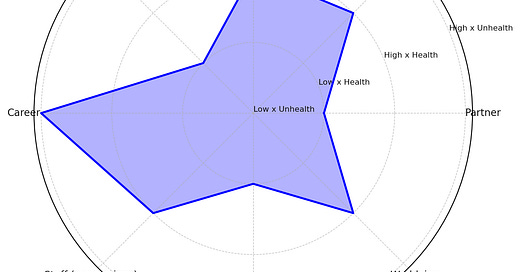If, upon tossing your cap into the sky to celebrate your graduation from college, someone had pulled you aside and handed you a list of true things about your future life, that list no doubt would include facts that would stress you out, like a lot.
Maybe there’s a divorce. A parent will die young. You will get fired from a job. Finances could be dicey, for a time at least. You will struggle to connect with your children, and ultimately will be disappointed by your relationship with them, or maybe they will just say terrible things to you. You or your spouse will receive a terrible diagnosis.
Some mix of these things happen to everyone, and yet, if we knew about it ahead of time it would massively impact our ability to get out of bed each morning, to say nothing of our willingness to take risks in love and life. So in our youth (aka First Adulthood) we build ourselves up through a cycle of hope, planning, doing, and validation that helps to create an Ego that does its job.
And for our first 35-45 years or so it works pretty well. But at some point these disappointments and afflictions materialize and we have to make sense of them.
The psychological pain and frustration of midlife are a function of the delta between where we derive our value and the tough reality when those things are drained of their power. And our ability to make sense of and make peace with this new reality is critical in moving through midlife in a healthy way so we can become a Wise, Healthy, and Awesome Midlife Man (WHAMM).
A brief word on WHAMMs (to which we should all aspire).
Picture a dude who you respect, of a certain age. He has worked hard in his career but is chill about it, doesn’t work too hard and doesn’t talk about it too much. He has good friends. He has a loving (but imperfect!) marriage or partnership. He has a genuine interest in and personal connection to the things he chooses to buy, basically he has good reasons for what he does, and those reasons do not include showing off. He is pleasing to look at, not because of any genetic gift or extravagant grooming but because he understands that schlubbiness is not a replacement for humility and that we all benefit from raising our shared aesthetic bar.
Without going into too much detail about his personality, he is possessed of a certain good humor, does not take himself too seriously, sees life as a gift, is able to mourn and sit in sadness with himself and with others. What sets a WHAMM apart is that if tomorrow some dimension of his life should change dramatically, he would not utterly lose his shit, and he would absolutely in no way take it out on others. He might be shaken, he would certainly access a deep well of sadness, connected as he is to the fragility of life and the way life seems but a mist. But his identity is in these things, and therefore he can accept their loss without the loss of his self. He is in a sense a wounded healer.
A few WHAMMs from the movie and tv world you may be familiar with:
Atticus Finch – ok maybe a little TOO handsome
Adam Driver in the Marriage Story. He has a rough time of it, but seems like a pretty thoughtful guy
Paul Rudd in This is 40 – maybe on the Schlubby side, but makes up for it with that guitar (cool hobbies being a big part of WHAMness)
Eddie Murphy in Coming to America, a literal example of casting aside one’s worldly validation
The dude from This is Us. Ultimate “good husband” energy, and stylish in a non threatening way
[share your examples of WHAMMs in the comments!]
We’re all on a journey to become WHAMMs. So today I want to introduce a tool to help map our level of health across some key dimensions. This map is a work in progress, and I welcome your input on how we might iterate on it together.
I’m sure you’re familiar with spider charts, the kind made famous by the NFL draft. Here’s Eagles Cornerback Quinyon Mitchell’s chart from the draft, as well as a gratuitous photo of his interception in the NFC Championship game.
Let’s take that concept and apply it to midlife identity ego structures (why not!?).
For your review, I propose the following dimensions:
Partner (ie romantic relationship)
Kids (even if there are no kids in the picture, the potential for kids in our society still carries psychic weight and should therefore be included)
Physical appearance and vitality
Friends / social
Career
Stuff. Things you purchase. Accoutrements.
Hobbies and interests
Worldview. Can include religion and/or politics
And then for each dimension we need a ‘vertical’ axis. This is a bit more tricky because it’s not true that more is better. Instead we’ll look at what is essentially a 2x2. On one hand we have “Health vs Unhealth” and on the other we have “low vs high” weight.
Low x Unhealth: basically an area where you feel low-ego, but in an unhealthy way. Leads to resentment, bitterness, regret, victimhood, self-pity.
Low x Health: an area where you put little stock. Not that important to you. But you’re at peace with it.
High x Health: you get good self-vibes from this. You don’t over-identify with this, instead receiving it as a gift.
High x Unhealth: you overidentify with this area. If it is punctured you are not just sad, you despair. Can be threatening to others.
Put it all together and you get something that looks like this…
Introducing the Ego Domination and Growth for Awesome Reflections Chart (EDGAR Chart) (sample data included):
But Midlife guy, isn’t this a total navel-gaze that no self-respecting WHAMM would take part in? I appreciate your question. And while it’s possible that WHAMMs occur in nature, I think the reality is that it’s really freaking hard to navigate this stage of life (hence this sletter). The goal here is to minimize the navel-gazing while maximizing the personal growth towards optimal WHAMMness.
Use your EDGAR chart to spark honest thoughts about your where you’re getting validated, where you might be a little resentful, and where you might be at risk for some unwelcome Ego death. Hopefully this starts some conversations with some trusted bros in authentic friendship to help you on your journey.
In future installments we’ll explore more about WHAMMs, unhealthy alternative paths, and flesh out the EDGAR chart in more depth. Get excited.












So good. Can’t wait to take your WHAM quiz to get my own spider graph.
I was super inspired by this post. Offering Jason Isbell a prime WHAMM example and making my case here. https://jodypritchard.substack.com/p/jason-isbell-foxes-in-the-snow-and